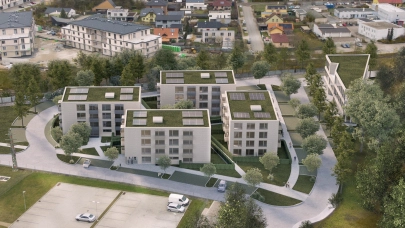
406,000 sqm of retail space was handed over on the Polish market in 2019. The development pipeline currently stands at approximately 500,000 sqm, 85% of which is scheduled for opening by the end of 2020. Going forward, investors’ interest will increasingly shift towards smaller cities below 100,000 inhabitants. Cushman & Wakefield has summarized the Polish retail market.
Key findings:
- Investment activity on the Polish retail market hit €1.95 billion, largely in line with the transaction volumes in the last five years.
- Despite the relatively robust investment activity, retail yields moved out in 2019, standing at 4.75% for prime shopping centres in Warsaw.
- Poland’s total retail stock across all formats reached 15 million sqm in 2019 while new supply hit 406,000 sqm.
- The highest volume of the new supply (183,000 sqm) was delivered in shopping centres.
- The development pipeline scheduled for delivery in 2020-2021 across all retail formats amounts to 500,000 sqm.
- The overall vacancy rate for Poland’s eighteen biggest markets remains at a low of 3.9%.
- Prime shopping centre rents stand at €120-130/sqm/month in Warsaw.
- Looking ahead, investors’ interest will increasingly shift towards smaller cities below 100,000 inhabitants – these markets account for nearly 50% of the development pipeline.
- 2019 witnessed 406,000 sqm of new retail space delivered to the market across all retail formats; of that total, 46% was opened in shopping centres. Following Tescos’ restructuring and closure of several shopping centres, approximately 28,000 sqm of retail space was withdrawn from supply while another 50,000 sqm will soon be repurposed as standalone retail warehouses. Poland’s total retail stock currently amounts to 15 million sqm.
456 shopping centres, providing more than 11 million sqm of floorspace, continue to dominate the Polish retail market, accounting for nearly 73% of the nation’s total retail stock. Last year, another 183,000 sqm of shopping centre space was delivered and more than 84,000 sqm was completed in retail parks. The outlet sector expanded by the newly-built 12,000 sqm Silesia Outlet Gliwice.
Half of the new supply came on stream in Poland’s largest cities, including Warsaw, which saw the opening of the 78,500 sqm Galeria Młociny shopping centre. Smaller cities and towns with populations below 100,000 accounted for 27% of last year’s new retail supply.
Smaller cities will continue to attract heightened interest from investors in the near future, with nearly 50% of the development pipeline expected to be delivered there. The increasing market saturation in key metropolitan areas and the changing shopping patterns and consumer expectations are having a knock-on effect on retail supply that will be dominated in the coming years by small convenience shopping centres, retail parks and mixed-use schemes, says report author Małgorzata Dziubińska, Associate Director, Consulting & Research, Cushman & Wakefield.
More than 500,000 sqm of retail space is currently under construction and 85% of that total is scheduled for opening by the end of 2020. Although shopping centre development activity decelerated sharply last year (-35% year-on-year), approximately 220,000 sqm of shopping centre floorspace is expected to be delivered in 2020, representing a 23% increase on 2019’s level.
Twenty international brands decided to expand into the Polish retail market in 2019. Newcomers included an Italian menswear retailer Gagliardi, a German bodywear brand Sloggi, and a global luxury brand Hermès. The market is still awaiting the entry of the Irish fashion retailer Primark into Poland (Galeria Młociny in Warsaw), and American Urban Outfitters (Elektrownia Powiśle in Warsaw) - both retailers have scheduled their entries for 2020.
Shopping centre footfall levels dropped in the early days of Sunday trading restrictions but gradually recovered as time went by. The FootFall Index of the Polish Council of Shopping Centres, indicating the average monthly shopping centre footfall, improved by 4% year-on-year in 2019, while the average turnover per square metre across all retail categories stood at PLN 882.
According to the data of the Polish Council of Shopping Centres, entertainment and F&B outperformed with 12% and 10% year-on-year increases, respectively, as shopping centres expanded their leisure and F&B components. Services that have recently been in an expansion mode across retail schemes posted a steady turnover growth of 9%.
At the end of 2019, the shopping centre vacancy rate averaged 3.9% for Poland’s eighteen largest markets. Of the eight largest metropolitan areas, the highest vacancy rates were in Krakow (6.1%), Łódź (5.6%), and Poznań (5.4%). Cities with 100,000-200,000 inhabitants reported a low of 2.0% due to their lower shopping centre density rates.
Prime shopping centre rents hold firm with a slight upward trend. Warsaw retains the top spot with prime rents for a 100 sqm unit in its best-in-class shopping centres at €120-130/sqm/month. Rents are lower in other major cities and stand at €40-52/sqm/month for similar units.
Secondary shopping centres with a limited retail offer or in less successful locations are experiencing increasing downward pressure on rents due to strong competition and growing market saturation in Poland. As a result, the shopping centre market polarization continues to widen, leading to more marked differences in average rental rates, says Małgorzata Dziubińska.
Despite the redirection of interest towards industrial and office real estate, 2019 was another good year for the Polish retail market, which saw more than €1.95 billion worth of investment deals -largely in line with the transaction volumes recorded in the last five years. Notable trends on the retail market include the growing interest in sale & lease-back acquisitions where landlords lease back retail properties under lease agreements for more than ten years.



